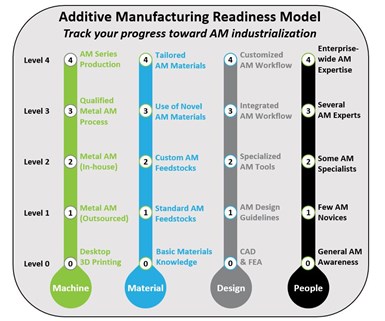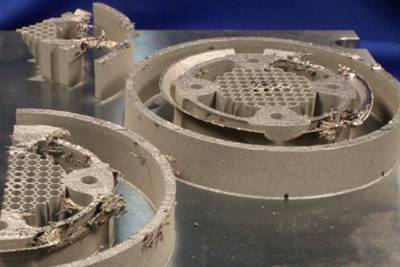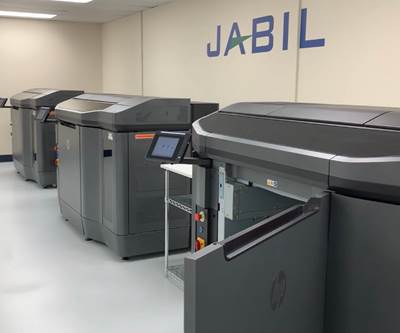Getting Ready for Additive Manufacturing
Readiness needs to be assessed on multiple fronts as companies seek to industrialize additive manufacturing.
Share










Hwacheon Machinery America, Inc.
Featured Content
View More
There is broad agreement within the industrial space that additive manufacturing (AM) still faces many harsh realities. From the cost of machines and material feedstocks, to the technological risks and uncertainties, to the lack of standards and design allowables, to the challenging workflows and toolchains, AM still has many hurdles hindering its industrialization. Luckily, the conversation among many seems to have shifted lately, with less focus on the hype and more emphasis on the practical aspects of AM and its implementation.
A big part of this shift stems from all of the belt-tightening that is going on in industry these days, particularly in AM. Many companies invested heavily in AM over the past 5-6 years, and the return on their investments may not have been as rosy as they had predicted. Granted, the ongoing pandemic certainly has not helped, but as noted last month, it is still hard to make a strong case for AM in many industries and applications. I am not saying that it can’t be done (there are many good examples out there), but it must be done carefully and realistically. The sooner you can integrate AM into your thinking, the better the outcome.
Part of the shift also stems from people getting tired of seeing the same AM parts and examples recycled over and over again. I think they want — maybe even crave — new and useful insights to help them on their own AM journey. My focus in these columns has concentrated on the basics and fundamentals of AM, and it is time to shift my focus to more detailed aspects of AM implementation. As part of this, I will begin sharing more of the many (mis)adventures that I have had on own AM journey both in academia, doing research and teaching students about AM, and in industry, training and helping companies deploy AM in their organizations.

Figure 1: An Additive Manufacturing Readiness Model to help companies track their progress toward AM industrialization.
Given all of the challenges that companies face when implementing AM, I find that it is useful to think about AM readiness on multiple fronts — not just how well an individual or a group within an organization knows AM. While many like TRLs (Technology Readiness Levels) and MRLs (Manufacturing Readiness Levels), AM readiness does not fit into a single bucket or category in its current state. Instead, we need to think about AM readiness on multiple fronts, and I offer the following to start: (1) machines, (2) materials, (3) design, and (4) people as shown in Figure 1. Yes, there are many other important aspects (e.g., post-processing, inspection, qualification, certification), but I find that these four are often the most frequent stumbling blocks within an organization as they begin their journey.
As shown in the figure, AM readiness is assessed from each perspective using five levels, where Level 0 represents the “table stakes” for each. For example, people must be generally aware of AM and be comfortable using CAD and FEA (finite element analysis) before the company can start its journey in earnest. With the goal of industrializing AM within a company, the top-most level is enterprise-wide AM knowledge that customizes workflows and/or tailors materials to enable series production with AM. The intermediate levels provide guideposts along the way and were developed in collaboration with John Barnes of The Barnes Global Advisors (TBGA) who have developed the TBGA AM Maturity Model to help match product requirements to AM skills and knowledge.

Figure 2: Examples of how a company might progress readiness from one project to the next.
The resulting AM Readiness Model becomes a useful tool to help get everyone on the same page within an organization — where they are as well as where they would like to be. It can be used to plot the progression of AM projects within an organization as shown in Figure 2. Alternatively, it can serve as a tool for benchmarking other AM organizations working in the same industry. The model can also be used to help manage people’s expectations on the AM journey. For instance, a company may struggle achieving a qualified metal AM process (Level 3 on Machine) if it only has a few AM novices in-house (Level 1 on People). Likewise, the ability to use novel or tailored AM materials (Levels 3 and 4, respectively, on Materials) is highly unlikely if a company is still outsourcing its metal AM capabilities (Level 1 on Machine).
Finally, the model can help companies identify where they need to co-invest or where they hope to see returns on an investment. For instance, moving to specialized AM tools (Level 2 on Design) requires some AM specialists within the organization (Level 2 on People), and both require an investment in new software and training to use it. The same logic applies to bringing metal AM in-house (Level 2 on Machine): it would be tough to yield any return on such an investment if there were only a few AM novices in house (Level 1 on People) or designers were insistent on sticking with CAD and FEA (Level 0 on Design).
I invite you to adapt this model to your needs and your organization. Some of you may find it too simplistic, in which case I challenge you to add more detail to each level or create intermediate steps between them. Meanwhile, others may find the simplicity a useful way to start a conversation about the time and investment needed to move from one level to the next. Mind you, there are no hard and fast rules or numbers for any of these levels right now given the state of AM, but I encourage you to start thinking differently about your organization’s AM journey if you have not already done so. Having just one number or criterion, or advancing a technology up a TRL scale, is likely not enough to get you where you need to be with AM.
Related Content
4 Tips for Staying Profitable in the Face of Change
After more than 40 years in business, this shop has learned how to adapt to stay profitable.
Read More4 Commonly Misapplied CNC Features
Misapplication of these important CNC features will result in wasted time, wasted or duplicated effort and/or wasted material.
Read More4 Rules for Running a Successful Machine Shop
Take time to optimize your shop’s structure to effectively meet demand while causing the least amount of stress in the shop.
Read MoreCustom Workholding Principles to Live By
Workholding solutions can take on infinite forms and all would be correct to some degree. Follow these tips to help optimize custom workholding solutions.
Read MoreRead Next
The Harsh Realities of Additive Manufacturing
Now is the time to start talking about what is really holding back additive manufacturing.
Read MoreWhat Your CEO Needs to Know About Additive Manufacturing
Additive manufacturing promises to affect far more than manufacturing alone. When evaluating AM, the perspective needed is the view that sees the impacts all across the enterprise.
Read MoreJabil Prepares for Production AM: It’s Down to the Basics Now
Jabil is getting ready for additive manufacturing to take its place as a production option in addition to conventional processes such as molding and machining. AM can and will fill this role, the company says — the focus now is on controlling cost and assuring quality and reliability.
Read More


















































